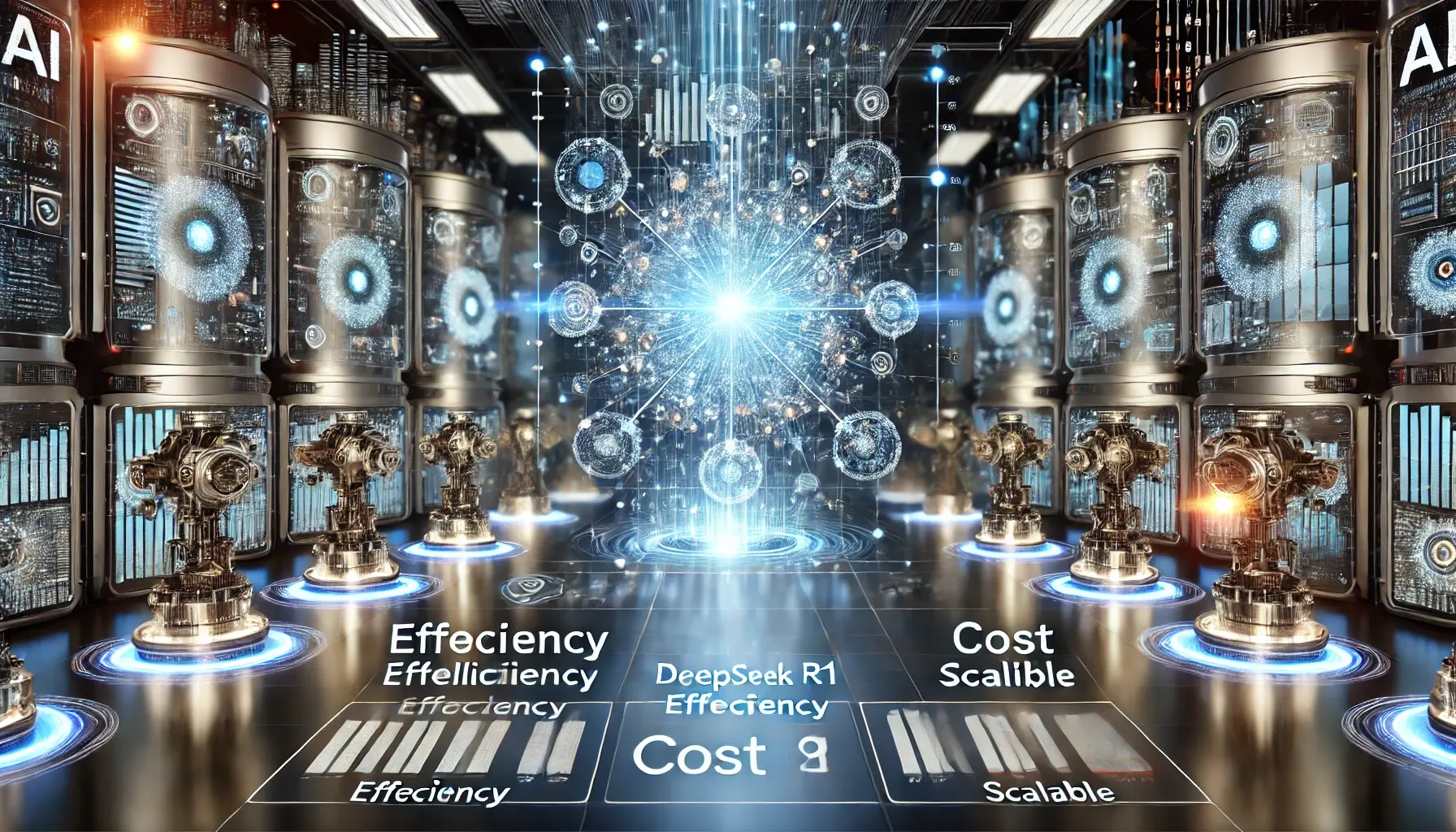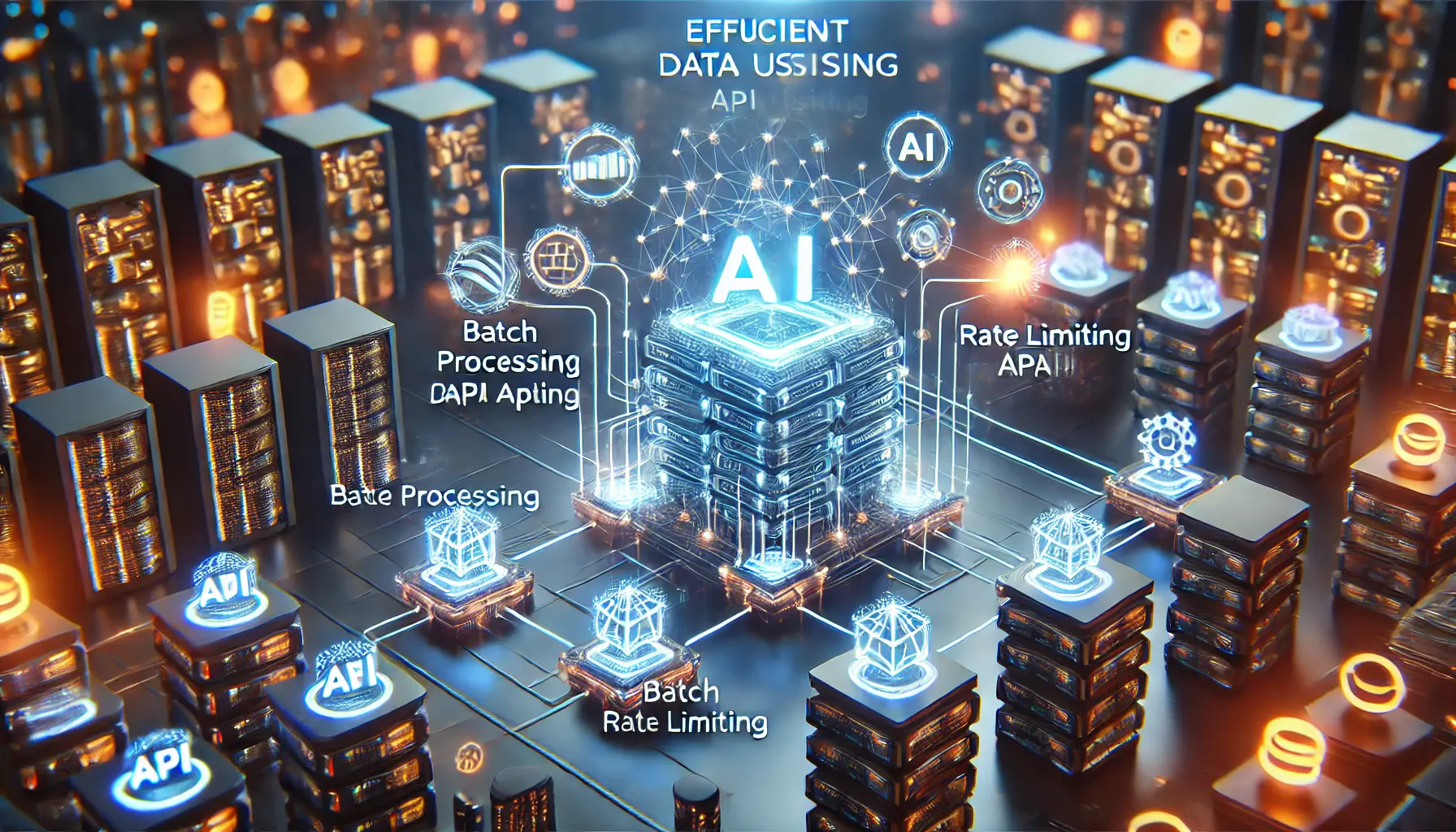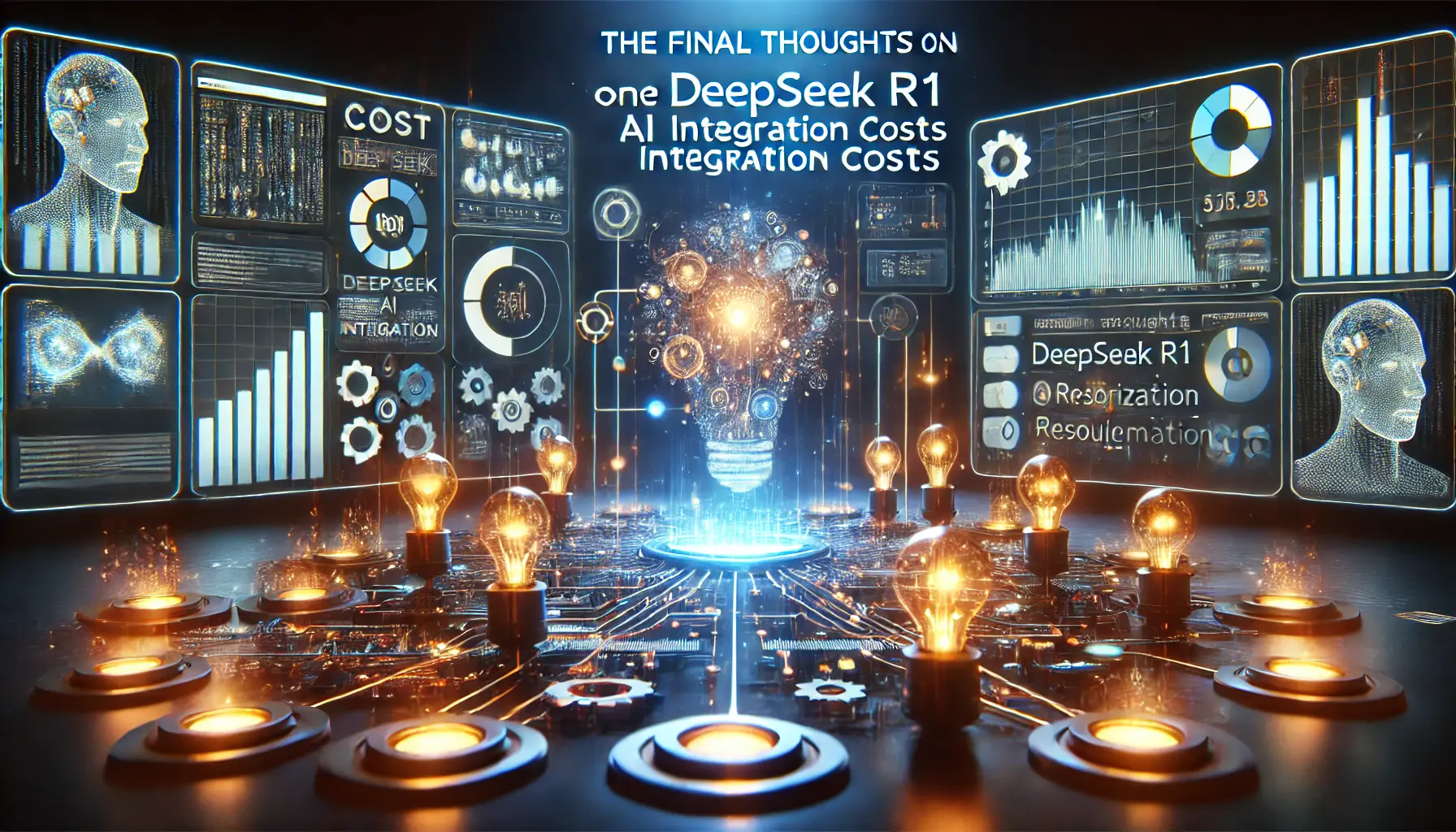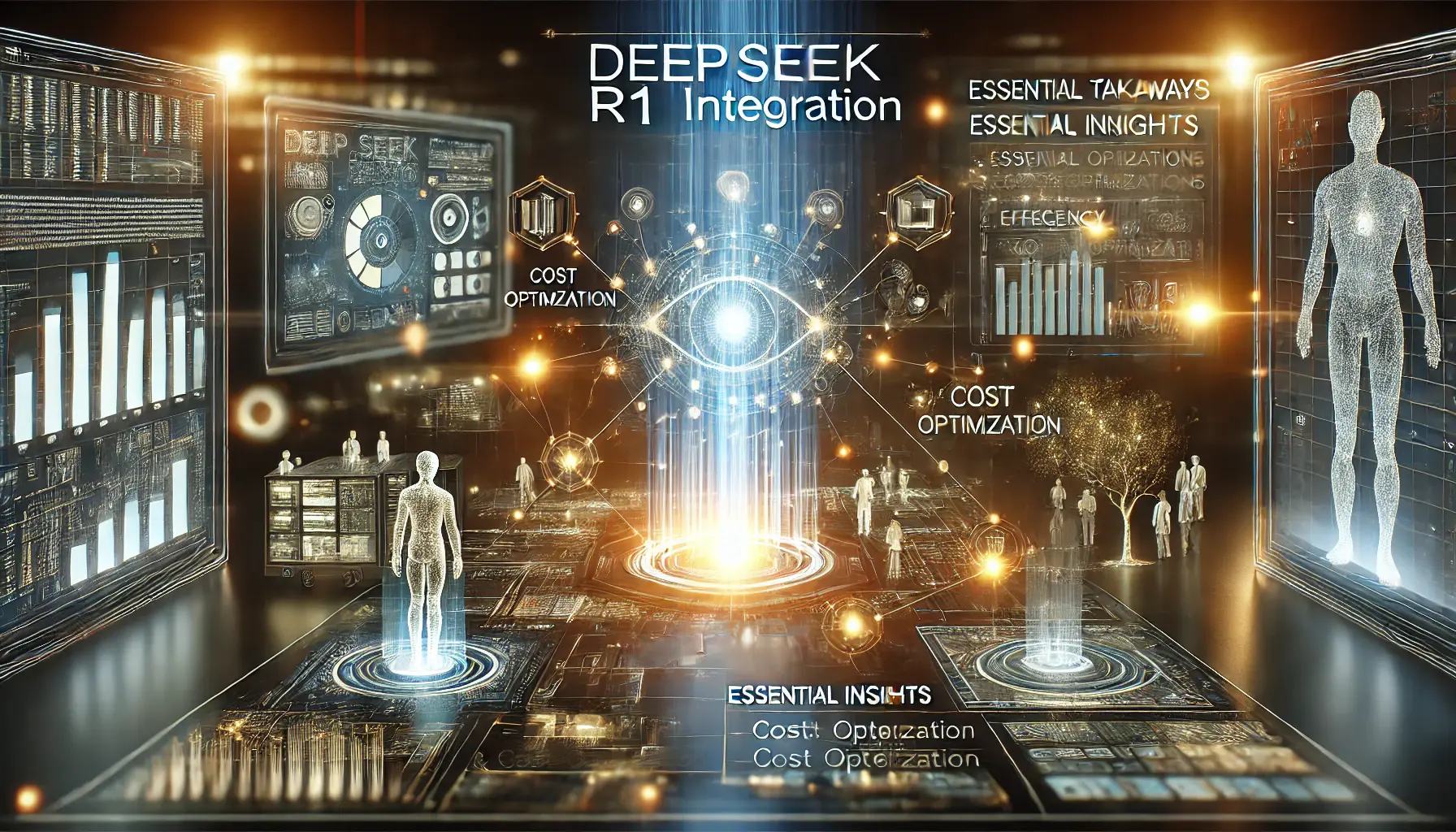In today’s rapidly evolving technological landscape, integrating advanced AI models like DeepSeek R1 into your operations can be a game-changer.
However, understanding the associated costs is crucial for effective planning and implementation.
Let’s delve into the key features and capabilities of DeepSeek R1 to grasp its value proposition fully.
Introduction to DeepSeek R1
DeepSeek R1 is a state-of-the-art artificial intelligence model developed to enhance reasoning capabilities across various applications.
Its design focuses on efficiency and performance, making it a compelling choice for businesses aiming to leverage AI for complex problem-solving.

A visualization of DeepSeek R1’s advanced AI processing and real-time data analysis capabilities.
Overview of DeepSeek R1
At its core, DeepSeek R1 is engineered to process and analyze data in real-time, providing swift and accurate insights.
This real-time data processing capability ensures that businesses can make informed decisions promptly, a critical factor in today’s fast-paced environment.

A high-tech representation of DeepSeek R1’s key features and capabilities, emphasizing real-time data processing and AI adaptability.
Key Features and Capabilities
DeepSeek R1 boasts several notable features:
- Real-Time Data Processing: Enables immediate analysis and response, facilitating timely decision-making.
- Multi-Domain Applicability: Versatile across various industries, from healthcare to finance, adapting to the needs of each sector.
- Long Context Handling: Handles extensive and complex data inputs efficiently to ensure comprehensive analysis.
- User-Friendly Interface: Designed for seamless integration into existing systems with minimal technical expertise required.
These features collectively contribute to DeepSeek R1’s robust performance, making it a valuable asset for organizations seeking to implement advanced AI solutions.

A high-tech visualization comparing DeepSeek R1 with other AI models, highlighting efficiency, cost, and scalability.
Comparison with Other AI Models
When evaluating AI models, it’s essential to consider factors such as performance, cost, and scalability.
DeepSeek R1 distinguishes itself through its open-source nature, allowing for greater flexibility and customization compared to proprietary models.
Additionally, its efficient architecture often results in lower operational costs, providing a cost-effective alternative without compromising on performance.
By understanding these aspects of DeepSeek R1, businesses can better analyze how it fits their specific needs and make informed decisions about its integration.
DeepSeek R1 is designed for advanced reasoning, providing businesses with real-time insights and efficient AI-driven decision-making.

A futuristic representation of DeepSeek R1’s cost structure, showcasing token-based pricing and computational resource management.
Cost Structure of DeepSeek R1
Understanding the cost structure of DeepSeek R1 is essential for businesses planning to integrate this AI model into their operations.
The pricing is based on tokenA unit of text used in natural language processing, which can be a word, number, or punctuation mark. usage, with distinct rates for input and output tokens, as well as considerations for context cachingA method of storing previously processed information for reuse, improving efficiency and reducing costs..

A high-tech representation of DeepSeek R1’s token-based pricing structure, highlighting cost efficiency and computational usage.
Pricing Breakdown per Million Tokens
The cost for utilizing DeepSeek R1 is as follows:
- Input Tokens: $0.14 per million tokens (cache hit); $0.55 per million tokens (cache miss).
- Output Tokens: $2.19 per million tokens.
It is worth noting that a token can be a word, number, or punctuation mark, and the total number of input and output tokens processed by the model forms the basis of billing.

A high-tech visualization of input and output token flow in an AI system, representing DeepSeek R1’s token-based pricing structure.
Input and Output Token Costs
The inputs given to the model are input tokens, while the outputs generated are considered output tokens.
Each of these is further divided into cache hits and cache misses:
- Cache Hit: When the model pulls information from its cache, it has a lower price of $0.14 per million input tokens.
- Cache Miss: When the model processes new information not stored in the cache, leading to a higher cost of $0.55 per million input tokens.
Output tokens are uniformly priced at $2.19 per million tokens, encompassing all tokens generated by the model in its responses.

A visual representation of context caching in DeepSeek R1, showing the impact of cached and non-cached data on pricing and efficiency.
Context Caching and Its Impact on Pricing
Context caching refers to how DeepSeek R1 might save and then reuse previously processed information, which means it can save time and increase efficiency.
This mechanism significantly influences pricing in the following ways:
- Cache Hits: Using prior cached information reduces the computation load, which lowers the cost of input tokens.
- Cache Misses: Processing new information that is not cached requires more computation, therefore increasing the cost of input tokens.
By effectively managing context caching, businesses can optimize their use of DeepSeek R1 and control associated costs, ensuring efficient AI operations while keeping expenses in check.
Understanding the pricing model of DeepSeek R1, including input and output token costs, is crucial for budgeting and cost control.

A visualization of the key factors contributing to AI integration costs, such as hardware, network, and storage infrastructure.
Factors Influencing Integration Costs
Integrating DeepSeek R1 into your business operations involves several cost considerations beyond the basic pricing structure.
Understanding these factors is crucial for effective budgeting and implementation.

A visualization of the critical infrastructure components needed for AI integration, such as servers, GPUs, storage, and network capabilities.
Infrastructure Requirements
Implementing DeepSeek R1 necessitates a robust infrastructure capable of handling high computational demands.
This includes:
- Hardware Investments: Procuring high-performance servers and GPUs to support the model’s processing needs.
- Storage Solutions: Ensuring adequate data storage for managing large datasets and model outputs.
- Network Capabilities: Establishing reliable and high-speed internet connections to facilitate seamless data transmission.
These infrastructure components are essential to maintain the efficiency and performance of DeepSeek R1 within your operations.

A visualization of the development and implementation expenses involved in AI integration, highlighting stages like customization, integration, and testing.
Development and Implementation Expenses
The process of integrating DeepSeek R1 involves several development and implementation costs, such as:
- Customization: Making the model fit your specific business needs.
- Integration: Seamlessly embedding the model into your existing systems and workflows.
- Testing: Performing extensive tests to ensure that the model works as expected in your operational environment.
All these activities require allocated resources for the successful integration of DeepSeek R1.

A visualization of the importance of maintenance and support in AI integration, including updates, technical support, and training programs.
Maintenance and Support Considerations
DeepSeek R1 requires ongoing maintenance and support post-integration to sustain optimal performance.
Key considerations include:
- Regular Updates: Implementing software updates to continuously improve features and address potential vulnerabilities.
- Technical Support: Ensuring access to expert assistance for timely troubleshooting and issue resolution.
- Training Programs: Conducting training sessions to help your team effectively learn how to use and manage the model.
Investing in these areas ensures that DeepSeek R1 continues to operate efficiently, delivering long-term value to your business.
Beyond token costs, businesses must consider infrastructure, implementation, and maintenance expenses when integrating DeepSeek R1.

A visualization of strategies for optimizing AI integration costs, including batch processing, API optimization, and cloud-based cost reductions.
Strategies to Optimize Integration Costs
Integrating DeepSeek R1 into your business operations can be a significant investment.
However, by implementing effective strategies, you can optimize these costs and maximize the return on your investment.

A visualization of the advantages of open-source in AI systems, emphasizing collaboration, customization, and cost savings.
Leveraging Open-Source Benefits
DeepSeek R1 is an open-source AI model, which offers several advantages:
- No Licensing Fees: Being open-source, it eliminates the need for costly licensing agreements, reducing initial expenses.
- Community Support: Access to a broad community of developers can aid in troubleshooting and provide enhancements, minimizing support costs.
- Customization: The open-source nature allows for tailoring the model to fit specific business needs without incurring additional costs.
By capitalizing on these benefits, businesses can significantly reduce integration expenses.

A visualization of efficient API usage, emphasizing batch processing, rate limiting, and data optimization for AI systems.
Implementing Efficient API Usage
Efficient use of APIs is crucial for cost management:
- Batch Processing: Grouping several requests into one API call can lower the number of calls, thus reducing the cost.
- Rate Limiting: Monitoring API usage ensures that unnecessary calls are avoided, keeping costs in check.
- Data Optimization: Sending only the required data reduces processing time and the associated costs.
These practices help ensure that API usage remains cost-effective while maintaining optimal performance.

A visualization of utilizing cloud service discounts and offers to optimize AI integration costs, including reserved instances and promotional credits.
Utilizing Available Discounts and Offers
Many cloud service providers offer discounts and other incentives that can significantly lower integration costs:
- Reserved Instances: Committing to long-term usage can be much cheaper than on-demand pricing.
- Spot Instances: Utilizing extra cloud capacity at a discount can further reduce costs.
- Promotional Credits: Taking advantage of promotional offers can help offset initial integration expenses.
By leveraging these options, companies can effectively control and reduce the cost of integrating DeepSeek R1, making the deployment process more feasible and sustainable.
Leverage open-source advantages, optimize API calls, and utilize cloud provider discounts to reduce integration expenses.

A visualization of successful DeepSeek R1 integrations across various sectors, highlighting real-world applications and their positive outcomes.
Case Studies: Successful DeepSeek R1 Integrations
Exploring real-world applications of DeepSeek R1 provides valuable insights into its practical benefits and the cost efficiencies it offers across various industries.

A visualization of AI democratizing financial advice, using personalized data and analytics to deliver insights to a broad audience.
Financial Services: Democratizing Financial Advice
In the financial sector, DeepSeek R1 has been utilized to provide comprehensive financial advice.
Its advanced reasoning capabilities enable it to analyze complex financial data and offer personalized recommendations, making financial guidance more accessible to a broader audience.
This application not only enhances service delivery but also reduces operational costs by automating complex analytical tasks.

A visualization of AI-powered resume analysis in human resources, emphasizing the efficiency and automation of evaluating candidate qualifications.
Human Resources: AI-Powered Resume Analysis
Within human resources, integrating DeepSeek R1 with platforms like FastAPIA high-performance web framework for building APIs with Python, known for its speed and ease of use. has led to the development of AI-powered resume analyzers.
These systems efficiently assess candidate resumes, identifying key qualifications and experiences that align with job requirements.
This automation streamlines the recruitment process, leading to significant time and cost savings for organizations.

A visualization of AI application development in the technology sector, highlighting advanced AI systems and coding environments.
Technology Sector: Enhanced AI Application Development
In the tech space, vendors have started deploying distilled versions of DeepSeek R1 using Amazon BedrockA cloud service by AWS that enables businesses to build and scale generative AI applications..
This integration enables developers to create advanced AI applications that maximize performance while minimizing resource usage.
The result is greater efficiency, reduced operational costs, and a faster time-to-market.
These case studies showcase the versatility and cost-effectiveness of DeepSeek R1 across different industry segments.
With its advanced capabilities, businesses can further enhance their operations, deliver superior services, and achieve significant cost savings.
DeepSeek R1 has proven effective in finance, HR, and technology, streamlining operations and reducing costs.

A visualization of evaluating and optimizing DeepSeek R1 integration costs, with cost analytics and resource management tools.
Final Thoughts on DeepSeek R1 Integration Costs
Integrating DeepSeek R1 into your business can be a transformative move, offering powerful AI-driven capabilities.
However, understanding its cost structure, factors influencing pricing, and strategies to optimize expenses is crucial to ensuring a smooth and cost-effective implementation.

A visualization of the key takeaways from DeepSeek R1 integration, highlighting efficiency, cost optimization, and data processing.
Key Takeaways from DeepSeek R1 Integration
In this article, we have discussed everything from the pricing structure of DeepSeek R1 to its real-world applications.
Below is a summary of the key points:
- Cost Breakdown: The cost depends on token usage, further broken down by input, output, and context caching.
- Influencing Factors: Hardware investment, software integration, and ongoing maintenance are major contributors to overall cost.
- Cost Optimization Strategies: Leveraging open-source benefits, efficient API management, and utilizing cloud service discounts can significantly reduce expenses.
- Real-World Applications: Businesses in finance, HR, and technology have successfully integrated DeepSeek R1, achieving cost savings and improved efficiency.

A visualization of the decision-making process in AI integration, emphasizing thoughtful analysis and resource optimization.
Making an Informed Decision
For businesses considering DeepSeek R1, it is essential to assess the long-term benefits against the associated costs.
While initial integration expenses may seem substantial, the long-term advantages—including automation, enhanced decision-making, and scalability—often outweigh the investment.
Organizations should also explore opportunities to optimize usage, such as utilizing batch processing to reduce API calls and leveraging cloud-based incentives to minimize infrastructure costs.

A visualization of evaluating DeepSeek R1’s suitability for a business, focusing on decision-making and optimization.
Is DeepSeek R1 the Right Fit for Your Business?
The decision to integrate DeepSeek R1 depends on your organization’s needs and resources.
If your business relies on AI-driven automation, natural language processing, or data analytics, then DeepSeek R1 can provide significant value.
However, careful financial planning and optimization strategies are required to maximize its benefits.
By understanding the cost dynamics and implementing effective cost-saving measures, businesses can successfully integrate DeepSeek R1 while maintaining financial efficiency.
While initial costs may be significant, the long-term efficiency and automation benefits of DeepSeek R1 make it a strategic investment.

A visualization of frequently asked questions about DeepSeek R1 integration, focusing on inquiry resolution and AI system connections.
DeepSeek R1 Integration: Frequently Asked Questions
Integrating DeepSeek R1 into your operations can raise several questions.
Below are some of the most commonly asked questions and their concise answers to assist you in understanding this AI model better.
DeepSeek R1 is an open-source AI model developed by DeepSeek, designed for advanced reasoning tasks, including complex problem-solving and data analysis.
Unlike many proprietary models, DeepSeek R1 is open-source, allowing for greater customization and flexibility in various applications.
Costs include hardware investments, software integration, ongoing maintenance, and potential expenses related to training and support.
Utilize open-source benefits, implement efficient API usage, and explore available discounts from cloud service providers to reduce expenses.
The open-source nature of DeepSeek R1, combined with its scalability, makes it adaptable for all types of organizations, including small and medium-sized enterprises.
Finance, human resources, and technology are some of the industries where DeepSeek R1 has been applied to enhance operations and reduce costs.
The DeepSeek R1 community offers extensive support through forums, documentation, and collaborative platforms to assist with integration challenges.
As with any AI integration, it is essential to implement robust security measures to protect data and ensure compliance with industry standards.
Yes, being open-source, DeepSeek R1 allows for extensive customization to align with unique business requirements and objectives.











